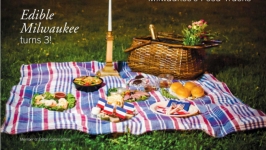Kohler and the American Club
A Wisconsin Company and Its Culinary Legacy
“The tables fairly groan under the loads of wholesome food and the men can eat as much as they wish,” wrote a reporter of his visit to the American Club in Kohler in its early days. “There is only one rule in the dining room: That is to clean the plate.”
A 1919 Christmas menu included purees of peas and celery, roast goose, cranberry jelly, potatoes, coleslaw and plum pie. A bowling banquet featured such bowling-themed and punny dishes as Potatoes tu Spare, Gravy la Bowl and Bowler’s Coffee.
The diners at these meals weren’t resort visitors or guests, however, but employees of the Kohler Company. And the American Club itself was a boarding house and community center for unmarried, largely immigrant men.
“Walter J. Kohler really wanted to provide a nice place to live for his workers, the ‘single men of modest means’ as he called them,” explains Angela Miller, archivist for the Kohler Company. “And he hoped the American Club would help the immigrants learn about America and become citizens.”
The Kohler Company had begun as an agricultural implement maker in Sheboygan in 1873, but transitioned to plumbing in the 1880s after founder John Michael Kohler added feet to an iron water trough and enameled the whole thing, turning something for horses and hogs into a fancy bathtub for people. He had good timing. Sinks, tubs, toilets and other components of the modern bathroom were becoming common in middle-class homes. By the late 1880s, enamelware and plumbing fixtures had overtaken plows as Kohler’s primary business.
Feeling that Sheboygan had grown too crowded (the city reported a little more than 25,000 people in the 1900 Census), John moved his company four miles west of Sheboygan to an area known as Riverside in 1899. Many were mystified by his decision since most of the workers lived in Sheboygan.
The local newspaper called it “Kohler’s Folly” but John wanted a more natural environment with room for expansion. Soon, some workers, rather than make the commute, began building homes near the foundry, and by 1912, Riverside had become a small town.
But it was a town without an appealing aesthetic. Walter Kohler, John’s son and now company president, decided to transform the area into a model village that showcased the company and its design philosophy. Disturbed by the blighted industrial communities he’d seen around the United States, Walter went to Europe where he examined various “garden cities” that combined industry and homes with green spaces for gardening and recreation.
Inspired, Walter returned home and hired the Olmstead Brothers, the firm responsible for Central Park, along with engineers and town planners to develop Riverside into Kohler Village. The result was a beautiful settlement of winding streets, parks, and homes set amid plentiful greenery. A separate company, the Kohler Improvement Company, sold the completed houses to employees and their families, at cost.
The American Club became the most prominent feature of the village’s business district when it opened in 1918. Walter, himself the son of immigrants (John had immigrated to the U.S. from Austria at age 10), wanted to provide a place for his foreign-born employees to begin a new life. Many had grown up in poverty, so their new home seemed luxurious.
Walter also hoped to educate workers on American life, offering free night classes in English, civics and American history, and decorating the facility with American flags and other symbols of their new country. So important was citizenship that the company designated an annual Naturalization Day for employees to file their papers while still receiving a full day’s pay.
“If this club, besides providing suitable living conditions, could be also an influence in the Americanization of the foreign-born and serve as a stimulus for a greater love of country and a desire for a higher citizenship, then its purpose will have been achieved,” Walter proclaimed at the opening of the American Club.
These workers had a short commute, simply crossing the street to the factory. The club was run to accommodate the workers’ shifts so meals and hot water were available at all hours. Hot food traveled from the American Club to the factory through an underground tunnel. The men paid $27.50 a month for a single room, laundry and three meals per day at the American Club.
The building included a bakery, modern kitchens, a laundry, card room, reading room and, this being Wisconsin, a bowling alley. After Prohibition ended, the American Club also had a bar, which is now the Horse & Plow restaurant. Nearly all of the food came from the Kohler farms. The men ate dinner family-style in a dining room that seated three hundred.
“They were quite self-sufficient with the farm,” says Miller. “The cellar held leeks, cabbages, and potatoes for meals that seemed to combine American and German traditions with the roasts and creamed everything popular at the time.”
Miller notes that wienerschnitzel was served every Sunday for many years. “And sauerkraut, lots of sauerkraut based on the report of 4000 heads of cabbage going into storage in 1917,” says Miller. It makes sense given the large number of German and Austrian workers drawn to Kohler, not to mention the Kohler family’s own heritage.
Because the American Club opened during the first World War, food conservation and preservation was an important feature of the dining hall’s early days. Miss Margaret Weimer, a graduate of what is now UW-Stout, monitored the health of the food as well as its accordance with national directives to conserve meat, wheat and sugar.
Even so, dinner service each day called for 150 pounds of meat; 5 bushels of potatoes; 13 gallons of canned tomatoes; 9 pounds of coffee; 50 loaves of bread; 11 pounds of butter; 15 quarts of milk; 10 pounds of sugar; and three pounds each salt and pepper.
As early as 1917, the company provided garden plots to workers. The company newsletter estimated that employees harvested 3,000 bushels of potatoes along with beans, peas, tomatoes, and cucumbers in 1917, likely as part of a war garden effort.
The garden plots grew in popularity throughout the 1920s and into the 1930s, particularly with the hardships of the Depression. To encourage gardening, the Kohler Recreation Club sponsored a Village Fair for residents to showcase their green thumbs.
By the mid-1930s, the village of Kohler was home to the company’s headquarters, foundry, ceramics plant, and design center along with 450 houses for workers and their families. Arts, music, gardening and recreational opportunities abounded.
But as the decades passed, the need for worker housing diminished. Remodeling in the 1940s turned a portion of the club into a village inn, but by the 1970s, some were calling for the American Club to be torn down. But Herb Kohler, grandson of the company founder, thought otherwise and pushed for the transformation of the building into a luxurious hotel. The building was placed on the National Register of Historic Places in 1978, just as renovations began that would turn the single rooms that had once housed immigrants into deluxe hotel rooms. The American Club opened as a resort in 1981 with food, particularly in recent years, as a major focus.
“Food is a daily need, just like the plumbing and bath fixtures we supply,” says Tricia Rathermel, events manager for Destination Kohler. “We see them as all connected and have since the American Club opened in the early 20th century.”
Matt Bauer grew up in Kohler, two blocks from the American Club. He’s recently become the Food and Beverage Manager for the American Club after ten years cooking at The Immigrant Restaurant, including more than five years as head chef.
“I started washing dishes at Cucina in high school, worked my way up and was cooking on the line by the time I graduated,” says Bauer.
The gardens that used to supply the produce for the American Club are long gone, though reserved plots for residents and employees endure. And employees at Kohler campuses around the world are growing food, too, from mangoes and coconuts in Aurangabad, India, to tomatoes and radishes in Tangier, Morocco.
That said, some food does remain a part of the landscape in Kohler. Tomatoes, peppers, summer squash, chard, carrots, and herbs are planted in a few spots around the American Club. They also grow oyster mushrooms on site.
Bauer says it can be hard to find farms that can supply enough food to meet the demand of the multi-restaurant Kohler resort. The American Club alone has five restaurants. An on-site bakery makes all the bread and the head baker has been nurturing his starter for more than twenty years.
“We rely on local farmers when we can and we’re trying to build more relationships across the state to find more opportunities to showcase them,” says Bauer.
One product area that’s well developed is cheese. The Immigrant Room features 40 to 50 cheeses, all from Wisconsin. Some cheesemakers simply arrive on Bauer’s doorstep, cheese in hand, hoping to make the cut.
“I love the story behind the cheese and the interaction with the makers almost more than I love the cheese,” says Bauer. “We have so many different types being made in Wisconsin that there’s no reason not to focus on our own state’s farms at the restaurant.”
Local has become a bigger part of the Kohler events as well in response to consumer interest in food. Besides the annual Food and Wine Experience, which brings celebrity chefs and other culinary experts in from around the country, Kohler hosts a Festival of Beer and recently launched a Wisconsin Food Favorites weekend. It’s also become a place to learn
with culinary classes in the demonstration kitchen and dinners with brewers and winemakers.
“People on the coasts look to the Midwest for raw ingredients and less for the end product so we really want to bring more attention to these great local producers,” says Rathermel. “We have this platform, this stage, for bringing attention to Wisconsin.”
Although the immigrant workers who once called the American Club home likely wouldn’t recognize it today, Rathermel says that the state’s history remains a touchstone.
“We may not look quite the same,” explains Rathermel, “but the traditions of our state and of the immigrants who came to live and work here endure.”








